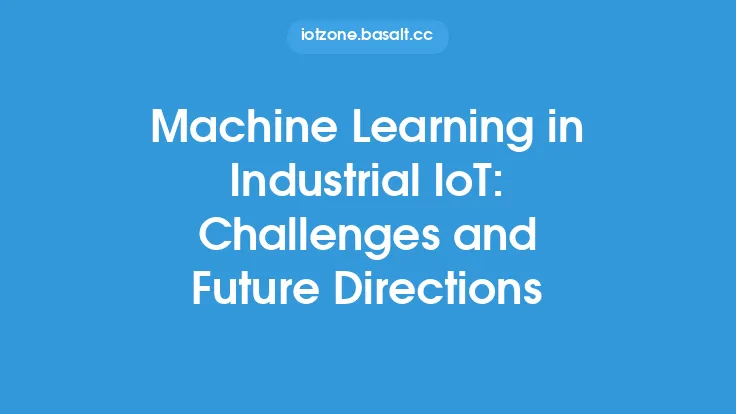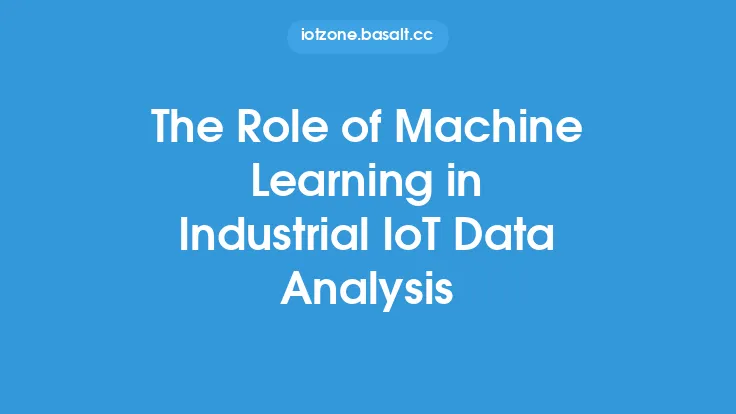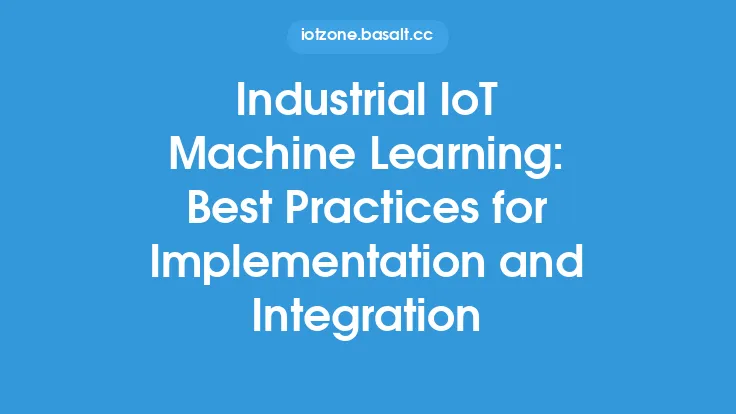The integration of machine learning (ML) in Industrial Internet of Things (IIoT) has revolutionized the way industries operate, making them more efficient, productive, and competitive. By harnessing the power of ML, industries can unlock significant business value, driving growth, and innovation. In this article, we will delve into the world of ML in IIoT, exploring its applications, benefits, and the technical aspects that make it a game-changer for industries.
Introduction to Machine Learning in IIoT
Machine learning is a subset of artificial intelligence (AI) that enables systems to learn from data, identify patterns, and make predictions or decisions without being explicitly programmed. In the context of IIoT, ML is used to analyze the vast amounts of data generated by sensors, devices, and machines, providing valuable insights that can inform business decisions. The application of ML in IIoT has numerous benefits, including improved predictive maintenance, enhanced quality control, and optimized production processes.
Technical Aspects of Machine Learning in IIoT
From a technical standpoint, ML in IIoT involves the use of various algorithms and techniques, such as supervised, unsupervised, and reinforcement learning. These algorithms are trained on large datasets, which can be structured or unstructured, to develop models that can predict outcomes, classify data, or identify anomalies. Some of the key technical aspects of ML in IIoT include:
- Data Preprocessing: The process of cleaning, transforming, and preparing data for use in ML models. This step is critical in ensuring that the data is accurate, complete, and consistent.
- Model Selection: The process of choosing the most suitable ML algorithm for a specific problem or application. This involves considering factors such as data type, complexity, and performance metrics.
- Model Training: The process of training an ML model using a dataset. This involves adjusting the model's parameters to minimize the error between predicted and actual outcomes.
- Model Deployment: The process of deploying a trained ML model in a production environment. This involves integrating the model with other systems, such as data pipelines, APIs, and user interfaces.
Applications of Machine Learning in IIoT
The applications of ML in IIoT are diverse and widespread, spanning various industries, including manufacturing, oil and gas, transportation, and healthcare. Some of the most significant applications of ML in IIoT include:
- Predictive Maintenance: The use of ML to predict equipment failures, reducing downtime and increasing overall efficiency.
- Quality Control: The use of ML to monitor and control product quality, detecting defects and anomalies in real-time.
- Supply Chain Optimization: The use of ML to optimize supply chain operations, predicting demand, and managing inventory.
- Energy Management: The use of ML to optimize energy consumption, predicting energy demand, and managing energy distribution.
Benefits of Machine Learning in IIoT
The benefits of ML in IIoT are numerous and significant, driving business value and competitiveness. Some of the most notable benefits include:
- Improved Efficiency: ML can optimize production processes, reducing waste, and increasing productivity.
- Enhanced Quality: ML can monitor and control product quality, detecting defects and anomalies in real-time.
- Increased Revenue: ML can predict demand, optimize pricing, and manage inventory, driving revenue growth.
- Reduced Costs: ML can predict equipment failures, reducing downtime, and increasing overall efficiency.
Challenges and Limitations of Machine Learning in IIoT
While ML has the potential to revolutionize IIoT, there are several challenges and limitations that must be addressed. Some of the most significant challenges include:
- Data Quality: ML requires high-quality data to produce accurate results. Poor data quality can lead to biased models and incorrect predictions.
- Model Complexity: ML models can be complex and difficult to interpret, making it challenging to understand the underlying decisions and predictions.
- Scalability: ML models can be computationally intensive, requiring significant resources to train and deploy.
- Security: ML models can be vulnerable to cyber threats, such as data poisoning and model inversion attacks.
Future Directions of Machine Learning in IIoT
The future of ML in IIoT is exciting and rapidly evolving, with new technologies and innovations emerging every day. Some of the most significant future directions include:
- Edge AI: The use of ML at the edge of the network, reducing latency, and increasing real-time processing.
- Explainable AI: The development of ML models that can explain their decisions and predictions, increasing transparency, and trust.
- Autonomous Systems: The use of ML to develop autonomous systems, such as self-driving cars, and drones.
- Human-Machine Collaboration: The development of ML systems that can collaborate with humans, increasing productivity, and efficiency.
Conclusion
Machine learning is a powerful technology that has the potential to unlock significant business value in IIoT. By harnessing the power of ML, industries can drive growth, innovation, and competitiveness, improving efficiency, quality, and revenue. While there are challenges and limitations to be addressed, the future of ML in IIoT is exciting and rapidly evolving, with new technologies and innovations emerging every day. As the use of ML in IIoT continues to grow and mature, we can expect to see significant advancements in areas such as edge AI, explainable AI, autonomous systems, and human-machine collaboration.





